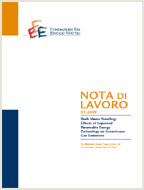Estimating Global Damages from Sea Level Rise with the Coastal Impact and Adaptation Model (CIAM)

Date
08.07.2015
08.07.2015
Authors
Delavane B. Diaz (Department of Management Science and Engineering – Stanford University)
JEL Code
C61, Q25, Q51, Q54
C61, Q25, Q51, Q54
Keywords:
Adaptation, Coastal Impacts, Climate Change, Sea Level Rise, Storm Surge, Flooding
Adaptation, Coastal Impacts, Climate Change, Sea Level Rise, Storm Surge, Flooding
Publisher
Climate Change and Sustainable Development
Climate Change and Sustainable Development
Editor
Carlo Carraro
Carlo Carraro
The costs of coastal sector impacts from sea level rise (SLR) are an important component of the total projected economic damages of climate change, a major input to decision-making and design of climate policy. Moreover, the ultimate costs to coastal resources will depend strongly on adaptation, society’s response to cope with the impacts. This paper presents a new model to assess coastal impacts from SLR, combining global scope with high spatial resolution to fill a gap between very detailed local studies and aggregate global estimates. The Coastal Impact and Adaptation Model (CIAM) determines the optimal strategy for adaptation at the local level, evaluating over 12,000 coastal segments, as described in the DIVA database (Vafeidis et al, 2006), based on their socioeconomic characteristics and the potential impacts of relative sea level rise and uncertain storm surge. An application of CIAM is then presented to demonstrate the model’s ability to assess local impacts and direct costs, choose the least-cost adaptation, and estimate global net damages for several probabilistic SLR scenarios (Kopp et al, 2014). CIAM finds that there is large potential for coastal adaptation to reduce the expected impacts of SLR compared to the alternative of no adaptation, lowering global net present costs by a factor of 10 to less than $1.5 trillion over the next two centuries, although this does not include initial transition costs to overcome an under-adapted current state. In addition to producing aggregate estimates, CIAM results can also be interpreted at the local level, where we find that retreat (e.g., relocate inland) is often a more cost-effective adaptation strategy than protect (e.g., construct physical defenses).
Suggested citation: Diaz, D. B., (2015), ‘Estimating Global Damages from Sea Level Rise with the Coastal Impact and Adaptation Model (CIAM)’, Nota di Lavoro 63.2015, Milan, Italy: Fondazione Eni Enrico Mattei.
